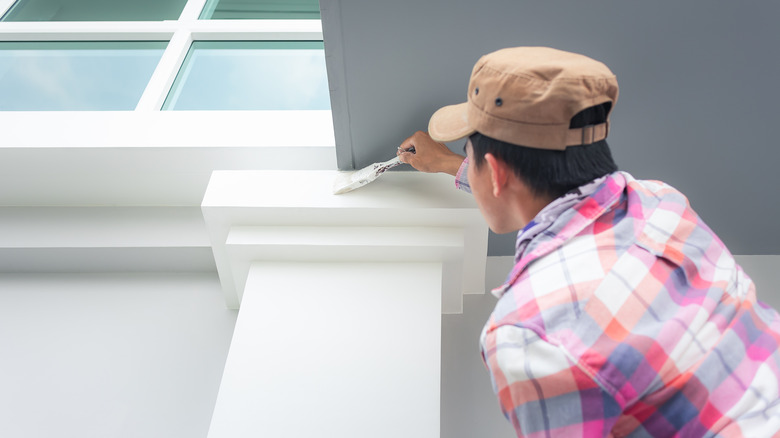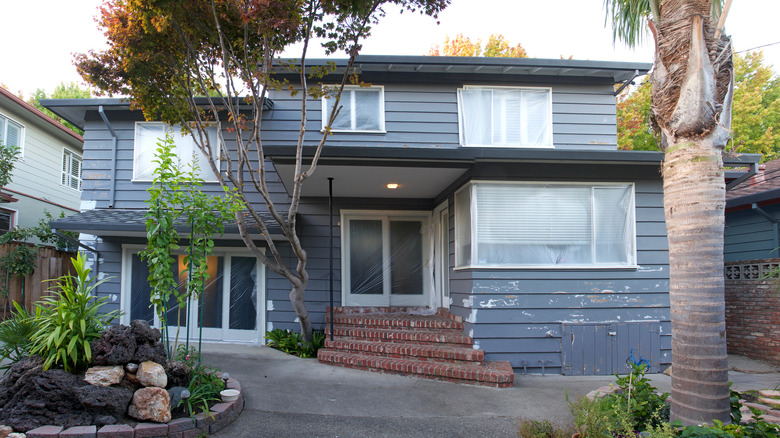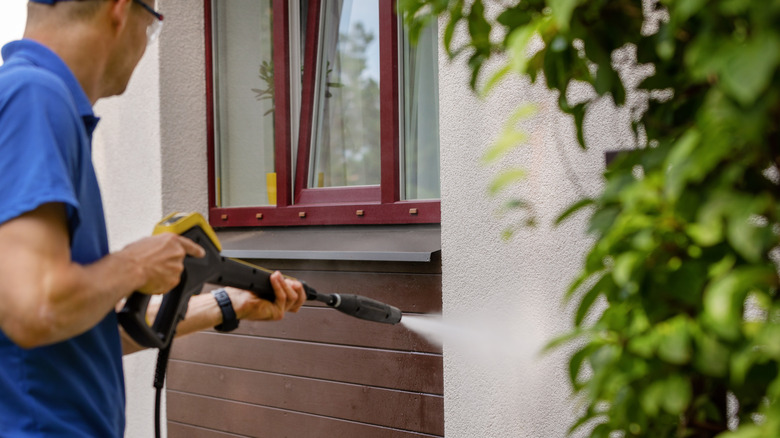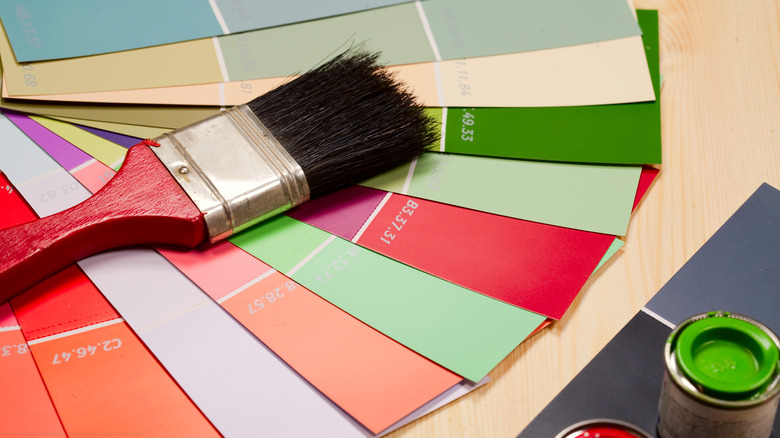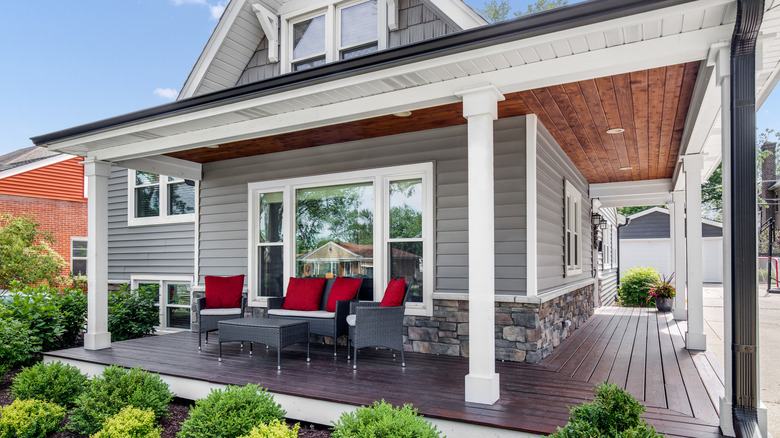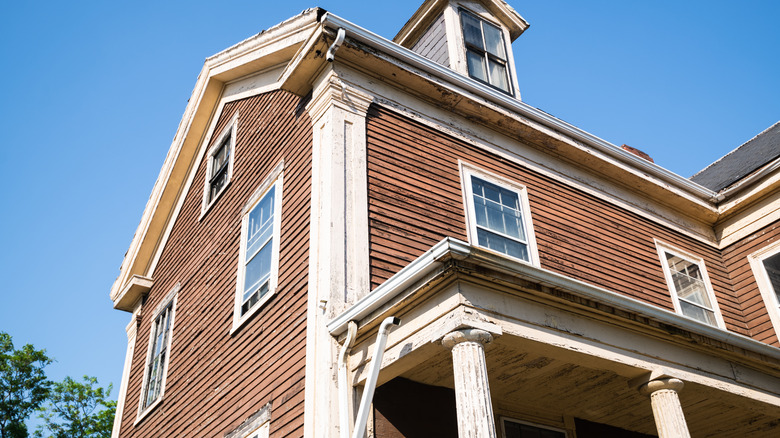How Much Does It Cost To Paint The Exterior Of Your Home?
You know the people in your neighborhood whose house has patches of peeling paint and a missing shutter from a hurricane 10 years ago? Maybe they've just put off painting their house because they don't know what it will cost or what kind of paint to choose. If that describes you, too, this article should help! One of the best ways to give your whole house a fresh, updated look is by painting the exterior. With proper cleaning and preparation, top-quality paint can last for 10 to 15 years, reports This Old House. They recommend choosing 100% acrylic paint not only because of its durability but because it can be used on any type of exterior surface.
It costs the average U.S. homeowner $5,362 to paint the exterior of a 1,500-square-foot house, per Fixr. The price can range from $2.50 to $6.50 per square foot, depending on the labor costs in your location, the number of stories, and the exterior condition. Some prep work is usually included in the hourly labor cost of painting, such as pressure washing, removing and replacing loose caulk, and some light carpentry, if needed. However, if your house exterior needs extensive repairs or mold removal, it could increase the labor costs by $15 per hour. Have your contractor write out exactly what will be included in the prep work and what they will charge per hour if they need to do more work.
Factors that impact cost
Size of House
The exterior size of your house includes areas such as the gables, dormers, shutters, doors, and maybe even your garage, which increases the estimated surface space. It takes about 10 gallons to paint a 1,500-square-foot house.
Local Labor Costs
Per Fixr, labor costs range from $25 to $100 per hour for each painter, depending on your area. It can take two painters, each working approximately 16 to 32 hours, to paint the trim and siding on a 1,500-square-foot home. On average, a skilled painter can paint an area between 150 to 350 square feet per hour. Labor costs should also factor in the time for set up and clean up. Costs increase for 2- and 3-story houses as setting up, climbing, and moving ladders and equipment take longer.
Quality of paint and specialized ingredients
Paint has four main ingredients: binders, pigments, solvents, and additives. The cost of paint varies greatly across brands and even within the same brand because of the quality and the ratio of those ingredients. Binders are the key ingredients that determine how the paint will perform overall, from adhering to the surface to retaining its color, writes Dunn-Edwards Paints. Pigments give the paint its colors. The best quality pigment is titanium dioxide. Its bright, white color gives the maximum amount of opacity, and creates the cleanest color before the tint is added, explains Essar International. Better quality pigments provide full coverage with just one coat, which means less work, and less cost. Look for the volume solids percentage, which refers to the binders and pigments that are left on the painted surface after the solvents evaporate. Anything over 45 percent is considered good quality because it means you'll end up with a stronger, thicker coating. An inexpensive paint with a high percentage of solids may have had fillers added to it to make it appear to have a higher volume of solids.
Solvents are the liquids in which the binders and pigments are suspended and which evaporate on the painted surface. Water is the solvent for paint, referred to as "acrylic" or "latex." Finally, additives determine the paint's ability to perform particular functions such as durability, drying time, temperature tolerance, and moisture resistance, writes Shoreline Painting. They can also affect how shiny or matte a finished surface looks.
Additional costs
Type of Finish
Paint comes in five finishes: matte, eggshell, satin, semi-gloss, and high gloss. Matte paint ranges in price from $15 to $40 a gallon; eggshell and satin are priced between $30 to $50 per gallon; semi-gloss sells between $40 to $60 per gallon, and high gloss ranges from $50 to $70, per Fixr. Glossy paint has a higher amount of resin binders and a lower amount of pigment. It's more durable because the resin binder encases and protects the pigment from scratching easily. It also makes the paint more water-resistant. Selecting a paint finish is a trade-off, though. Glossy paint draws attention to surface imperfections, per Paint Topics, while eggshell is matte enough to hide imperfections but still has enough of a sheen to be washable. It is the most commonly used paint finish.
Type of Siding
Some surfaces require more priming, and some use less paint. Engineered wood takes fewer coats than hardwood, making it less expensive, writes Shoreline Painting. Hardwood siding has to be sanded and primed before painting which increases the costs. Stucco is the most expensive surface with its own unique process.
Lead paint remediation
If your house was built before 1978, it may have originally been painted with lead-based paint. The manufacture and use of lead-based paint were banned in 1978, and your house may have been painted many times over the years since then. However, even very small amounts of lead dust can poison your child or unborn child. As of April 2010, the Environment Protection Agency (EPA) enacted the Lead Renovation, Repair and Painting Rule (RRP), which is a federal law requiring contractors who do any type of home renovations, repairs, or painting on houses built before 1978 to be EPA-approved and certified as their work will generate lead dust and chips, per Zota Pro.
There are several methods for remediating the areas of lead-based paint hazards, including encapsulation, enclosure, removal, and replacement. Costs range from $4 to $10 per square foot, except for total removal, which can range from $10 to $17 per square foot. Start by contacting a lead inspector to find out if your house has lead paint. The EPA also provides resources to contact your state's Childhood Lead Poisoning Prevention (CLPP) program for more information.
Types of exterior paint
Acrylic
The overall best type of exterior paint will have "100% acrylic" or "all-acrylic" binders, which make them the most weather-resistant, flexible, and colorfast, according to Forbes. Plus, it can be used on wood, vinyl, metal, and masonry. There are other acrylic paints that use vinyl- or acrylic blends. Adding some confusion is the fact that there are paint brands that use the words acrylic and latex interchangeably. Today, there is no natural latex in paint. All acrylic paints are defined by the different types, and percentages, of vinyl or acrylic polymers that are used as the binders in the paint, according to Difference Between. Acrylic paint ranges from about $20 to $50 per gallon, per Fixr.
Oil-based paint
Oil-based paint is still used for certain high-traffic areas and exterior elements, but the less sustainable ingredients, harmful off-gasses, and a tendency for lighter colors to yellow or crack over time have limited its use. Oil-based paint cannot be used on brick, stone, or stucco as it traps moisture which would eventually damage the mortar. Oil paint costs between $20 and $70 per gallon.
Specialty paints
A number of specialty paints have ingredients that can extend longevity, resist UV disintegration, add a thicker coating, or extra shine. They are more expensive than acrylic or oil paint, and some must be applied by a company-certified contractor.
Solid-color stain
Stain creates a thin, tinted with a completely flat sheen which allows the wood texture to show through. It costs about $30 per gallon but is not as durable as paint.
Why you need to paint the exterior of your house
Painting the exterior of your house isn't just about appearance. There are two important reasons to keep your house well-painted.
Moisture
Paint covers and protects the surface of your house. If your house is sided with wood, the paint prevents its exposure to moisture, writes CertaPro, which can soften and rot it. From there, moisture can be absorbed by the wood and seep into your house, where it can damage ceilings and walls. Paint also acts as an extra barrier to keep insects from eating the wood. Not only do insects cause cosmetic and structural damage, but they attract woodpeckers which will drill through your siding to get to the insects, according to J.D. Hostetter.
Mold and mildew
Mold and mildew can grow on almost any type of surface, not just wood, and can get under the siding. It's easier for the mold to work its way into your house through cracks in the exterior paint or gaps where the flashing isn't properly installed. When your house is painted, these types of problems are discovered and repaired prior to painting. Mold and mildew have to be treated and removed before the paint can be applied, writes Beyond Exteriors.
Benefits of painting your house
Painting your home will do more than just protect your home. Here are two other benefits:
Curb appeal
If your home is in need of some touch-up, your neighbors are sure to notice when you have painted it and will appreciate the work that benefits the entire neighborhood! Painting the exterior of your home improves its curb appeal, per Barbour Painting.
Increases your home's value
Homelight reports that painting the exterior of your house can increase its value by $7,571. Their graph shows the Return on Investment (ROI) of curb appeal on a national level and by region. Even in an aggressive seller's market with strong buyer demand, buyers do not want to buy a house with deferred maintenance. Buyers don't want the headache of finding a painter and getting the house scheduled for a paint job. They may have been approved for a mortgage, but it doesn't mean they have the cash on hand for renovation and repairs.
